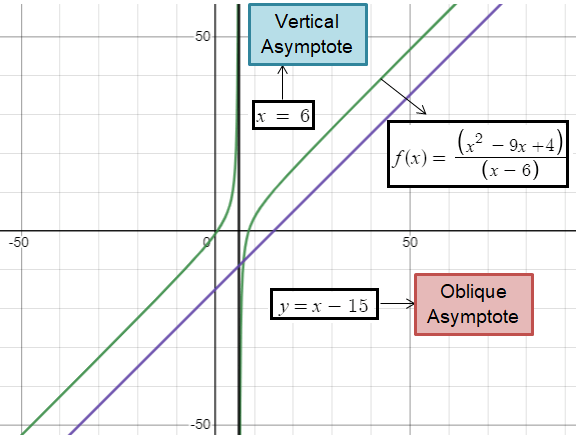HOW TO FIND EQUATIONS OF VERTICAL ASYMPTOTES
Subscribe to our ▶️ YouTube channel 🔴 for the latest videos, updates, and tips.
Vertical Asymptotes :
The Vertical Asymptotes of a rational function are found using the zeros of the denominator.

Describe the vertical asymptotes and holes for the graph of each rational function.
Problem 1 :
y = (x - 2)/(x + 2) (x - 2)
Solution :
y = (x - 2)/(x + 2) (x - 2)
We see x – 2 as a common factor in both numerator and denominator.
After cancel x – 2. We get,
1/(x + 2)
To find vertical asymptote, we equate the denominator to 0.
x + 2 = 0
x = -2
We see the hole at x = 2 in the graph.
x – 2 = 0 we will get hole at x = 2.
So, the vertical asymptote at x = -2; hole at x = 2.
Problem 2 :
y = x/x(x - 1)
Solution :
y = x/x(x - 1)
We see x is a common factor in both numerator and denominator.
After cancel x .We get,
1/x – 1
To find vertical asymptote, we equate the denominator to 0.
x – 1 = 0
x = 1
We see the hole at x = 0 in the graph.
We will get hole at x = 0.
So, the vertical asymptote at x = 1; hole at x = 0.
Problem 3 :
y = (5 - x)/(x2 - 1)
Solution :
Given, y = (5 - x)/(x2 - 1)
To find vertical asymptote, we equate the denominator to 0.
x2 – 1 = 0
(x + 1) (x – 1) = 0
x + 1 = 0 and x – 1 = 0
x = -1 x = 1
So, the vertical asymptotes at x = 1 and x = -1.
Problem 4 :
y = (x2 - 2)/(x + 2)
Solution :
Given, y = (x2 - 2)/(x + 2)
To find vertical asymptote, we equate the denominator to 0.
x + 2 = 0
x = -2
So, the vertical asymptote at x = -2.
Problem 5 :
y = (x2 - 4)/(x2 + 4)
Solution :
y = (x2 – 4)/(x2 + 4)
We see no common factor in both numerator and denominator.
To find vertical asymptote, we equate the denominator to 0.
x2 + 4 = 0
x2 = -4
So, no vertical asymptotes or holes.
Problem 6 :
y = (x + 3)/(x2 - 9)
Solution :
y = (x + 3)/(x2 - 9)
y = (x + 3)/(x + 3) (x – 3)
We see x+3 as a common factor in both numerator and denominator.
After cancel x + 3. We get,
1/(x – 3)
To find vertical asymptote, we equate the denominator to 0.
x – 3 = 0
x = 3
We see the hole at x = -3 in the graph.
x + 3 = 0 we will get hole at x = -3.
So, the vertical asymptote at x = 3; hole at x = -3.
Problem 7 :
y = (x2 - 25)/(x – 4)
Solution :
y = (x2 - 25)/(x – 4)
To find vertical asymptote, we equate the denominator to 0.
x – 4 = 0
x = 4
So, the vertical asymptote at x = 4.
Problem 8 :
y = (x - 2) (2x + 3)/(5x + 4) (x – 3)
Solution :
y = (x - 2) (2x + 3)/(5x + 4) (x – 3)
To find vertical asymptote, we equate the denominator to 0.
5x + 4 = 0
5x = -4
x = -4/5
x – 3 = 0
x = 3
So, the vertical asymptotes at x = -4/5 and x = 3.
Problem 9 :
y = (15x2 - 7x - 2)/(x2 - 4)
Solution :
y = (15x2 - 7x - 2)/(x2 - 4)
To find vertical asymptote, we equate the denominator to 0.
x2 – 4 = 0
(x + 2) (x – 2) = 0
x + 2 = 0 and x – 2 = 0
x = -2 x = 2
So, the vertical asymptotes at x = 2 and x = -2.
Subscribe to our ▶️ YouTube channel 🔴 for the latest videos, updates, and tips.
Recent Articles
-
Finding Range of Values Inequality Problems
May 21, 24 08:51 PM
Finding Range of Values Inequality Problems -
Solving Two Step Inequality Word Problems
May 21, 24 08:51 AM
Solving Two Step Inequality Word Problems -
Exponential Function Context and Data Modeling
May 20, 24 10:45 PM
Exponential Function Context and Data Modeling